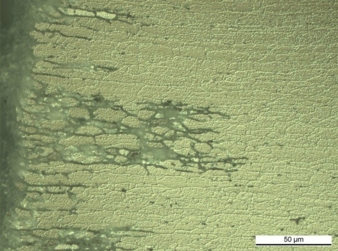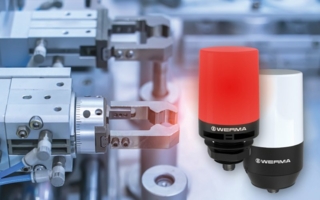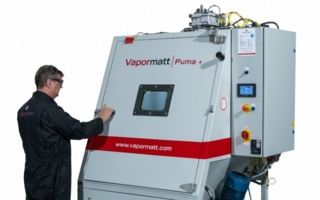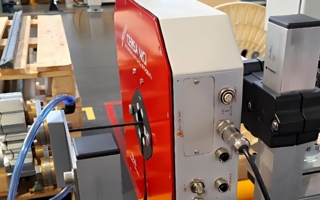04/11/2019
Corrosion resistant rod
Aluminium alloys with more resistance to intergranular corrosion (IGC), that's what the automotive industry needs. Rivets, bolts, screws and valves are produced out of 6xxx alloys. An investigation of the IGC behaviour of EN-AW 6082 rod indicates that chemical composition and process parameters have strong influence to its corrosion sensitivity.
The automotive industry needs aluminium alloys with improved resistance to intergranular corrosion (IGC). Rivets, bolts, screws and valves are produced out of 6xxx alloys. The investigation of the IGC behaviour of EN-AW 6082 rod indicates that chemical composition and process parameters have a strong influence to its corrosion sensitivity.
The Trimet Group provides the aluminium processing industry with primary metal, alloys, semi-finished products, castings and recycling. It produces and supplies the most diverse forms and alloys of aluminium – customized to the users’ special needs.
Lower CO2 emission targets have caused, among others, the need for lighter, more efficient vehicles, causing a dramatical increase of aluminium usage in the automotive industry. This has in turn generated the need for aluminium alloys with enhanced properties, such as an improved resistance to intergranular corrosion (IGC) for the 6xxx alloys. In the past years there have been investigations on the IGC behaviour of 6xxx extruded profiles, but rod, being considered a niche product, has not had the same focus. However, rivets, bolts, screws and valves are produced for the automotive industry out of 6xxx alloys, and they must often fulfil the same requirements as the extrusions. In this article, the IGC behaviour of EN-AW 6082 rod will be investigated.
The rods in different diameters were produced by Trimet France in the site of Castelsarrasin with a continuous casting and rolling process. In order to be able to evaluate and compare the results, the VW/Audi PV 1113 [1] test for ICG was chosen, given that it is very often used on aluminium extruded profiles. Results indicate that chemical composition and process parameters have a strong influence to the corrosion sensitivity of this material.
Rod and redraw-rod production
The rod was produced with a Clecim continuous casting and rolling machine (CCR). They were subsequently, in the labs of Trimet, homogenised, drawn with a final area reduction of 53%, annealed and heat treated.
Intergranular Corrosion (ICG)
Alloys of the 6XXX series are generally considered to have a good resistance against intergranular corrosion, and are widely used in the European car manufacturing industry. In the last years, investigations on extruded profiles, in particular of EN-AW 6082, have shown, however, that also alloys from this series are sensitive to this kind of corrosion (fig. 1). Although the attack mechanism is not clear yet, studies on EN-AW 6082 [2, 3, 4, 5, 6] have shown that there is more than one factor that influences the corrosion resistivity of the alloy.
Experimental
Two different EN-AW 6082 compositions, one with a standard copper (NCu), one with reduced copper content (LCu), were cast and used to produce the rods. The chemical composition of the two version of the alloy can be seen in table 1.
The rods were produced on the Trimet site of Castelsarrasin on an internally modified SECIM CCR machine. Their original diameter of the rod was 15.2mm, and they were delivered to the Trimet lab in Essen, Germany, in “F” condition. They were then homogenized (status “O”), drawn in three steps from a diameter of 15.2mm to 10.4mm, with a reduction ratio of 53% (status “H16”). They were then solutionized and heat treated to T6 temper. The homogenisation, heat treatment and T6 temper parameters were the same for both alloy variation, and were taken from the industrial praxis.
For each temper condition, a IGC corrosion test according to the PV 1113 was performed on the specimens. The surfaces have to be ground with a 120 grit iron free sandpaper, and then they must be cleaned with acetone and immersed in an ultrasonic bath with alcohol. The sample must be immersed in a new solution made of 1,000ml H2O, 20g NaCl, 100ml HCl (25%), with at least 8ml solution per cm² of the sample. Test duration is 2 to 2.5 hours at room temperature. The sample has to be cleaned with flowing water only immediately after it is taken out of the solution. After polishing, the depth of the IGC attack can be measured.
Results
The maximum corrosion depth was measured as shown in the figs. 2-13, both on the fresh cut face (FCF) and on the rod surface (S) and it is shown in table 2. The comparison between the two alloys shows that in all cases the LCu samples have lower corrosion depth than the co respective NCu specimens.
However, it can be clearly observed that the chemical composition is not the only relevant factor for the corrosion resistance. The heat treatment plays also a relevant role. The different microstructure of the samples as seen in the anodized samples reacts very differently to the corrosion attack.
The results show that the IGC sensitivity of EN-AW 6082 redraw-rods is influenced not only by the chemical composition and thermal history of the material, but also by its cold working history. In order to obtain good results it is therefore important to control and tune all this parameters.
Luisa Marzoli, Christiane Matthies and Hubert Koch, Trimet Aluminium SE
Dominique Cance, Magali Guizard and Peter Baumgart, Trimet France SAS
Trimet Aluminium SE
Aluminiumallee 1
45356 Essen/Germany
Contact person is Luisa Marzoli
Tel.: +49 201 366518
Trimet France SAS
Rue Henri Sainte-Claire Déville
73300 Saint-Jean-de-Maurienne/France
Literature
[1] Volkswagen AG Konzernnorm PV 1113, 2007-10, Klass.-Nr. 53312
[2] J.E. Lein, A. Bjorgum, J.H: Nordlien, Y. Yu, K. Nisancioglu, Effect of low copper content and heat treatment on intergranular corrosion of model AlMgSi alloys, Corrosion Science 48, 258-272, 2006
[3] G. Svenningngsen, J.C. Walsmsley, J.H: Nordlien, K. Nisancioglu, Effect on artificial aging on intergranular corrosion of extruded ALMgSi alloys with small Cu content, Corrosion Science 48, 1528-1543, 2006
[4] Kim Blommedal, Corrosion Development in welded AA 6082 alloys, NTNU- Trondheim Norwegian University of Science and Technology, June 2013
[5] N. Tyrell, Effect of natural and artificial aging on corrosion of extruded AA 6082, Trimet internal report, July 2013
[6] Friedrich Ostermann, Anwendungstechnologie Aluminium, 3. Auflage, 2014





